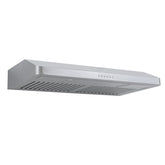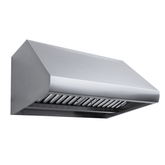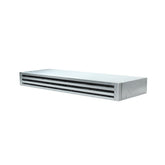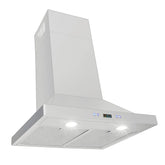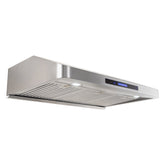You are wondering what a studor vent is. It's important to understand the basics and how it functions to ensure the proper operation of your plumbing system.
A studor vent is a type of plumbing fixture that contains a one-way diaphragm valve to allow air into drain pipes while preventing sewer gases from escaping. Studor vents provide easy and affordable venting compared to traditional roof venting methods.
Now that you have a brief understanding of what a studor vent is let's delve into its workings and benefits, along with some common installation questions and tips. By the end of this article, you'll have a deeper understanding of this crucial plumbing component and how it fits into your home's overall system.
The Anatomy and Mechanics of a Studor Vent
They work by allowing air to enter and equalize pressure in the system while preventing sewer gases from entering back into your living space.
The primary components of a studor vent are the one-way valve and the vent pipe. These parts work in harmony to ensure smooth function. Here's a brief explanation:
- Air intake: When water flows through your plumbing system, it creates negative pressure. The vent pipe detects this change and opens the one-way valve, allowing air to enter the system and equalize pressure. With adequate air supply, wastewater can flow smoothly through the pipes.
- Air expulsion: Once the water stops flowing and the negative pressure dissipates, the one-way valve closes, sealing off the vent pipe. This action prevents sewer gases from escaping into your home through the studor AAV.
How that is different from traditional venting methods… It's all in the simplicity and adaptability. Traditional vent pipes often require more space and can be challenging to install in smaller or complex layouts. These AAV vents provide a more accessible option as they require minimal space and can be installed without extending through your roof.
Different Types of Studor Vents
When it comes to venting your plumbing system, there are a couple of popular options: Mini-Vent, Maxi-Vent, and Tec-Vent.
Mini-Vent: The Mini-Vent suits 1.5-2 inch pipes. It is ideal for small residential plumbing like sinks, tubs, washing machines. Compact for tight spaces.
Maxi-Vent: The Maxi-Vent fits 3-4 inch pipes. It is suitable for larger commercial and multi-story applications. Increased capacity vents multiple fixtures smoothly.
Tec-Vent: The Tec-Vent also fits 1.5-2 inch pipes. It is an AAV with a diaphragm to regulate air pressure for smooth water flow.
Each of these operates under the same principle - they allow air to enter the plumbing system when there is a negative pressure due to water flowing through the pipes, and they close once the pressure is stabilized to prevent sewer gases from entering your home.
How Studor Vents Work
By using the principle of convection, these vents draw in moist air and expel dry air, helping maintain a balanced atmosphere.
When you operate a plumbing fixture, negative pressure is created in the pipes. This pressure change causes the need for proper venting, allowing air to enter the drains and equalize air pressure. Studor vents function as one-way mechanical valves that are installed locally at the site of a plumbing fixture. They enable proper venting without connection to a more extensive venting system or stack vent.
What makes studor vents useful is their ability to work efficiently under negative and positive pressure circumstances. When the negative pressure is induced in the plumbing system, the vent opens to admit air, balancing air pressure and preventing the draining water from producing gurgling noises or emitting foul smells.
Conversely, when positive pressure is detected, the vent remains closed, preventing sewer gas and odor from entering your home.
Installation and Placement of Studor Vents
When installing one, you'll want to first choose the optimal location. Keep in mind that the vent should be easily accessible for maintenance and inspection but also sufficiently far away from the fixture to function properly. The distance can vary, but roughly from 2' 6" to 16 ft is an acceptable range.
The vent needs to be upright or within 15 degrees of vertical to work effectively. Avoid installing it horizontally, as it can lead to problems in its operation. One common place to install a studor vent is under a sink, which allows for a straightforward and unobtrusive installation.
Next, connect the vent to the horizontal branch drain by using a vent tee or a sanitary tee with a 90-degree bend. This will help to prevent any unwanted sewer gases from escaping into the room. Ensure that all connections are secure and watertight, adhering to relevant building codes and standards to guarantee a safe and efficient installation.
After completing the installation, test it to verify its operation. If the vent is working correctly, you should notice a significant reduction in any unpleasant odors and improved drainage performance in your plumbing fixtures. Always keep an eye on your vent for any signs of malfunction and address issues promptly to maintain a safe and efficient plumbing system.
Usage in Plumbing Systems
When you operate a plumbing fixture, such as flushing a toilet or draining a sink, the water needs to move smoothly through the drain system. As the water flows, the studor vent allows air to enter the pipe, equalizing the pressure. This prevents any unwanted gurgling noises, slow drainage, or unpleasant odors caused by trapped gases.
As discussed above, installing one is fairly simple and can be done near a plumbing fixture or on the main sewer line, where it enters the house.
They are especially useful in situations where traditional venting systems are difficult or impossible to install, such as in tight or confined spaces.
As the vent is a one-way valve, the design allows air to enter your plumbing system, but not leave, ensuring that potentially harmful gases and odors are kept out of your living spaces. They serve as an alternative to the traditional vent system that is connected to the outside air and prevents pressure buildup in your pipes.
Preventing Bad Odors and Gases
If you've ever experienced unpleasant odors or gurgling sounds in your bathroom or kitchen, a studor vent can be the perfect solution.
Sewer gases, such as methane, are produced by the decomposition of organic material in your sewage system. Installing a studor vent allows your plumbing system to expel these harmful gases while keeping your living space fresh and clean.
When water drains through your pipes, the vent maintains proper air pressure balance, preventing any backflow of odors or gases into your living space.
To ensure your studor vent is functioning optimally, it's crucial to follow proper maintenance practices. Keep your vents clean and free of debris, so they can effectively balance the air pressure in your plumbing system. This will ensure a smooth and odor-free drainage experience in your home.
By understanding how a studor vent operates and maintaining it, you can effectively prevent unwanted odors and harmful sewage gases from infiltration in your living space. So, enjoy the benefits of a properly functioning plumbing system and breathe easier in your fresh and clean home.
Codes and Regulations
When dealing with plumbing installations, it's essential to follow the codes and regulations to ensure your systems' safety and proper functioning.
First and foremost, you should consult your local building department and adhere to the plumbing code in your jurisdiction. The International Plumbing Code (IPC) is a widely accepted guideline, but specific requirements may vary by location.
According to the IPC, studor vents must be installed a minimum of four inches above the horizontal branch drain or fixture drain being vented. This placement allows for adequate air to enter the valve and ensures the system functions efficiently.
Accessibility is another important consideration. You need to install the studor vent in such a way that it is easily accessible for maintenance or replacement if required. For in-wall installation, consider using a recess box/grill combination which can simplify maintenance tasks.
Generally, always ensure your installation complies with all applicable codes and regulations. This keeps your plumbing systems functioning well and helps avoid potential fines or penalties from enforcement agencies. Remember, a friendly approach to understanding and adhering to the codes and regulations will make the installation process smoother and more successful.
Importance in Different Areas of Home
In your kitchen, the studor vent plays a critical role in regulating pressure differentials that may happen when using a range hood. When the range hood's exhaust fan operates, it creates negative pressure which pulls air out of the kitchen space. The help maintain adequate airflow and prevents potential drainage problems in the kitchen sink.
Moving on to bathrooms, studor vents become crucial in preventing potential backups and unpleasant odors from toilets and showers. When water flows through your plumbing system, pressure changes can cause slow draining or gurgling sounds. By installing these vents for your shower and toilet areas, you can ensure a hassle-free experience without any unwanted blockages or foul smells.
Island sinks and vanity areas also greatly benefit from the addition of a studor vent. Since these fixtures often lack an adjacent wall where a traditional vent pipe can be installed, an AAV proves to be a perfect alternative. It allows for a compact and flexible venting solution, giving you an efficient and visually appealing plumbing setup.
Maintenance and Inspection
Keeping your studor vent in good working condition is important to ensure it can perform its function effectively. To maintain your studor vent, you should inspect and clean it regularly. Here are some friendly tips to help you with the maintenance and inspection process.
First, make sure to carry out regular inspections of the ventilation device. These inspections should be performed at least once a year or more frequently if you have had any issues with the vent in the past. During the inspection, check for any visible signs of damage or wear on the external parts of the vent. Also, make sure the vent is securely attached in its designated location.
If you have a studor vent that's installed on your roof, remember to also perform the necessary roof maintenance tasks. This includes cleaning your gutters, removing any debris from the roof, and ensuring that the vent is accessible and free of physical obstructions. Roof maintenance is especially important as it can help prevent water damage and prolong the life of your ventilation system.
Benefits and Limitations
One of the primary benefits of a studor vent is its effectiveness in preventing backups and odors.
Studor vents offer flexibility in installation, making them an ideal choice for situations where traditional venting methods are not feasible or practical.
Another advantage is their low maintenance requirements. Once installed, they typically require minimal upkeep, contributing to the overall efficiency of your plumbing system..
Despite these benefits, it's important to note that studor vents come with certain limitations.
They may not be suitable for all plumbing setups, such as systems that experience high flows, like washing machines.
Additionally, they are not immune to malfunctions; therefore, it is crucial to stay vigilant and monitor their performance.
It is also worth considering that some warranties on plumbing fixtures may require specific venting methods, so opting for a studor vent might affect your warranty coverage.
Advanced Venting Solutions
In your quest for understanding studor vents, you might also be curious about other advanced venting solutions available. Worry no more! Below are a few paragraphs covering some of the most commonly used venting solutions: P.A.P.A. device, primer, relief vent, and open vent pipe.
A P.A.P.A. device (Positive Air Pressure Attenuator) is a specialized venting solution designed to protect your drainage system from excessive positive pressure. As water flows through the system, air pressure can build up, and P.A.P.A. devices balance this pressure by releasing trapped air, ensuring smooth water flow and preventing damage.
A primer, on the other hand, is useful in maintaining the water-sealed traps in your plumbing system. These traps prevent sewer gases from entering your home or building, and primers help by replenishing the water in the traps, ensuring they continue to work effectively.
Relief vents are an essential component of venting systems, providing additional airflow to main and branch vents within the plumbing system. By offering a secondary path for airflow, relief vents help maintain the air pressure balance in a system when multiple fixtures are in use. This ensures the optimal performance and efficiency of your plumbing system.
Lastly, an open vent pipe serves as a traditional venting solution and connects the plumbing system to the atmosphere. This type of venting allows gases, odors, and air from the drainage system to escape outside, maintaining proper air pressure within the system and preventing the water-sealed traps from being compromised.
- What is a Studor Vent? - Frequently Asked Questions
What are the benefits of using a studor vent?
A studor vent, also known as an Air Admittance Valve (AAV), helps balance air pressure within your drainage system, allowing water to flow smoothly and preventing odors from entering your living spaces. By using a studor vent, you can eliminate the need for traditional vent pipes that run through walls and roofs, which can save you time, effort, and construction costs. Furthermore, AAVs can be easier to install and maintain than traditional vent pipes.
When is it recommended to install a studor vent?
You may consider installing a studor vent in situations where traditional vent pipes are difficult to install or when modifications to plumbing systems are needed. Studor vents are commonly used in island sinks, plumbing remodels, or when adding fixtures in areas with limited space. They provide an effective and efficient way to vent your plumbing system without the need for extensive pipework.
What is the difference between an air admittance valve and a vent pipe?
An air admittance valve, like a studor vent, is a one-way valve that allows air to enter the drainage system when required, which helps balance air pressure and allows for smooth water flow. They are typically installed within the plumbing system itself. In contrast, vent pipes are installed alongside the drainage pipes and extend through the building's roof, allowing air to circulate in and out of the plumbing system. Vent pipes can be more complex to install and may require additional construction efforts.
What is the proper installation height for a studor vent?
The proper installation height for a studor vent depends on the specific requirements of your plumbing system. Typically, a studor vent should be installed at least 6 inches above the flood level of the highest fixture it is serving. This helps to ensure proper airflow and functioning of the vent. For accurate installation recommendations, you should always consult the manufacturer's guidelines or a licensed plumber.
How does a studor air admittance valve compare to an in-line vent?
A studor air admittance valve operates as a one-way vent to equalize pressure in the drainage system, while an in-line vent connects two or more plumbing fixtures to a shared vent pipe. Studor vents can be advantageous in situations with limited space or when traditional vent pipes are challenging to install. In-line vents might be a better choice if you are connecting multiple fixtures and can easily run vent pipes within your building.
How can I tell if a studor vent is necessary for my plumbing system?
If you are experiencing slow drainage, gurgling noises, or persistent sewer odors, a studor vent may help resolve these issues by equalizing air pressure in your plumbing system. Consider consulting a licensed plumber who can assess your specific plumbing setup and recommend whether a studor vent is necessary or if alternative solutions are more appropriate.
Did you get your answer to what is a Studor Vent? We hope you got that and then some. Come back for more info about all your DIY needs.
